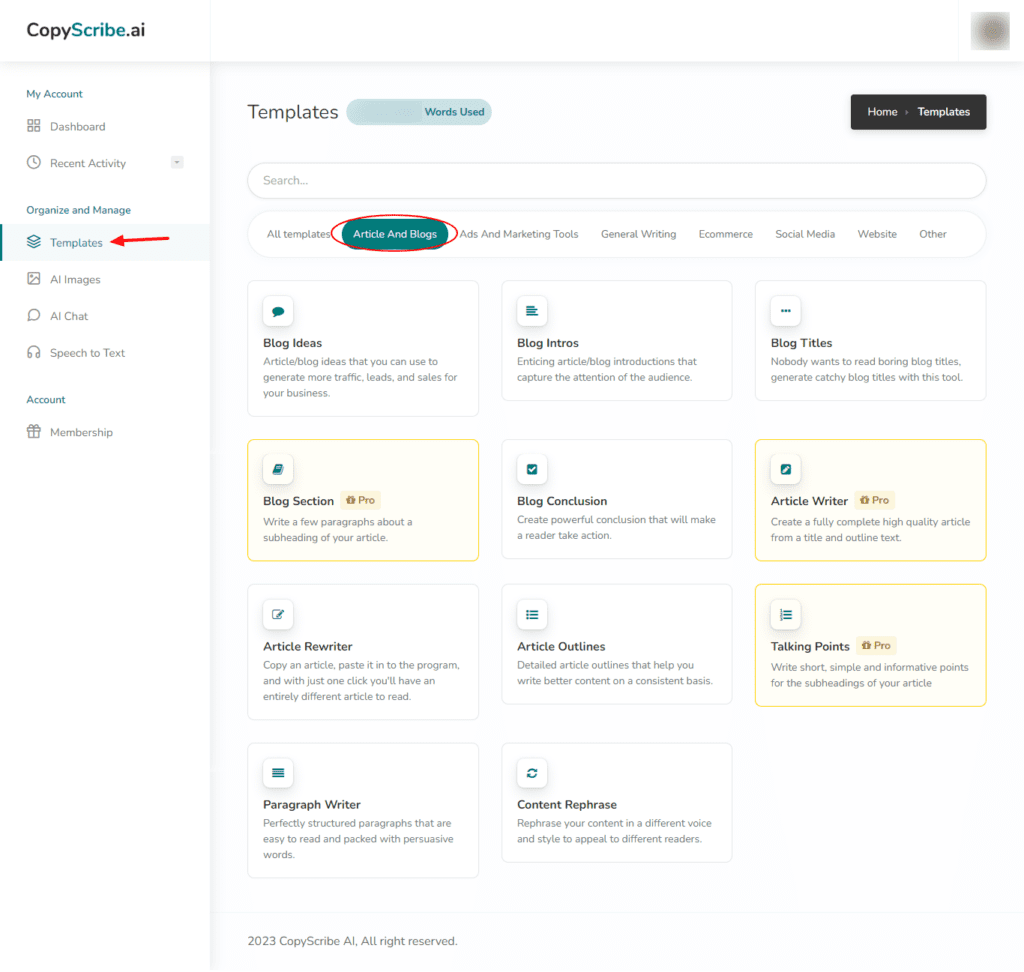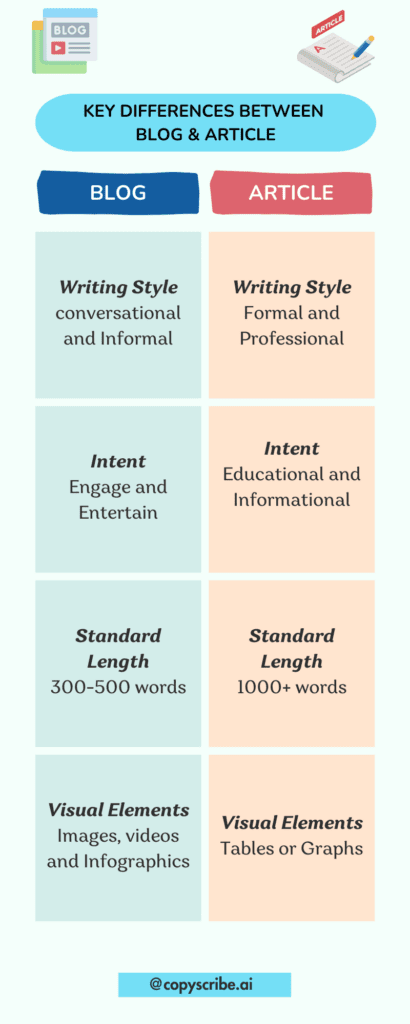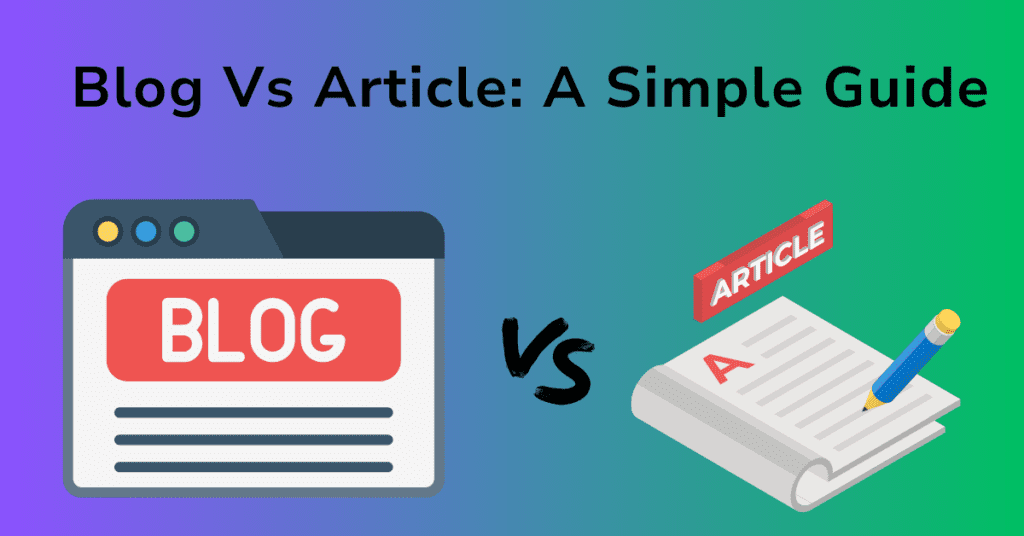Have you ever wondered what sets a blog post apart and different from an article? You’re not alone! The digital world is buzzing with content, and knowing the differences between the two can be your secret weapon. While both forms of content aim to inform, entertain, or inspire, they serve different writing purposes and follow different rules.
A blog post is generally more casual and aims to engage readers in a conversation. On the other hand, an article is generally more formal and informational, focusing on a specific keyword for search engine optimization.
Understanding the nuances of “blog vs article” can help you choose the right format for your message, ensuring it resonates with your audience and ranks well in search engines.
So, let’s dive in and unravel the mystery behind these two popular content types!
What is a Blog Post?
Regarding online writing, “blogs and articles” often get used interchangeably. However, they’re not the same.
A blog post is like a casual chat with your audience. Unlike formal articles, blog writing is more personal, engaging, and usually written in a conversational tone. Blog posts are generally shorter, making them easier to read in one sitting.
They often include opinions and anecdotes and are designed to encourage interaction. So, if you want to make a blog, remember that the key is to keep it relatable and engaging.
In a nutshell, blog posts are the friendly face of your brand, inviting readers to engage and come back for more.
Why Write Blog Posts?
So, you’ve heard about blogs and articles but are still determining why you should focus on writing blog posts. Well, you’re in the right place! Understanding the differences between blogs and articles is crucial for anyone diving into content creation.
Let’s explore why blog posts are a fantastic addition to your content strategy.
Easy to Digest: The Length Matters
One of the first things you’ll notice is that blog posts are shorter, usually 300 to 1000 words. This shorter length makes them easier to read and digest. In today’s fast-paced world, only some have the time to read a lengthy article. Blog posts offer a quick and engaging way to convey information or entertain, fitting perfectly into our busy lives.
Frequency: Keep ‘Em Coming
You’ll find that blog posts often appear more frequently than articles. Whether it’s daily, weekly, or bi-weekly, the regularity keeps your audience engaged and coming back for more. This frequent posting can help you build a loyal following who are genuinely interested in what you have to say.
Tone and Style: Be Yourself
Blog posts are written in a more casual and conversational tone. Unlike articles, which are often more formal and require thorough research, blogs allow you to showcase your personality. This personal touch can make your content more relatable and engaging, which is often what readers are looking for.
Versatility: A Blog Might Be All You Need
A blog might serve multiple purposes. It can be educational, entertaining, or even a bit of both. You can use it to share updates, offer insights, or simply express yourself. The versatility of blogs makes them a powerful tool for personal branding or business.
SEO Benefits: Keywords and More
Understanding the differences between blogs and articles isn’t just academic; it has real-world implications for online visibility. Blog posts often focus on specific keywords, making them an excellent tool for SEO. By incorporating targeted keywords, you can improve your site’s search engine ranking, thereby attracting a larger audience.
Whether you’re a business owner, a hobbyist, or someone who loves to write, blog posts offer a versatile and engaging format for your content. They’re shorter, more frequent, and often more relatable than articles, making them popular for writers and readers.
What is an Article?
An article is a formal piece of writing that dives deep into a specific topic. Unlike a blog post, articles are usually well-researched, fact-based, and aim to provide valuable information. Article writing often involves a structured format, including an introduction, body, and conclusion.
While a blog post may be more informal and opinion-based, an article is designed to educate and inform the reader.
You should read an article if you’re looking for a comprehensive and authoritative source on a subject.
Why Write Articles?
One of the key differences between blogs and articles is the length. While blog posts can be as short as 500 words, articles often range between 1500 to 5000 words. This extended word count allows you to explore a subject in depth, providing valuable insights that a shorter blog post might need to cover.
Articles Are Often Researched
Because articles are generally longer and more detailed, requiring extensive research. This research can include interviews, surveys, and a deep dive into existing literature. The result is a well-rounded piece that offers a balanced view.
Reach a Dedicated Audience
Articles are written for an audience willing to invest time in thoroughly understanding a topic. This makes articles ideal for complex subjects that require deep understanding.
SEO Benefits
While both articles and blogs can be optimized for search engines, the longer articles allow for a broader range of keywords and related terms to be included. This can help improve your website’s SEO and attract a more diverse audience.
Articles are the way to go if you intend to provide a comprehensive guide or explore a topic in-depth. They offer a formal, well-researched, and detailed approach to content creation that can help you establish authority in your field.
Blog Vs Article: Are They Same?
In content marketing, “blog post” and “article” are often used interchangeably. However, understanding the difference between a blog post and an article is crucial for anyone involved in content writing and marketing.
What do you think about articles and blog posts? Are they the same?
The short answer is no. While both are types of content, key differences set them apart.
Writing Style
The most noticeable difference in writing style is that blog posts are generally more conversational and informal. On the other hand, articles are more formal and often subjected to thorough editing for spelling and grammar. Articles need in-depth research.
Intent
Blog posts are usually designed to engage the reader and are often built around SEO keywords to attract organic traffic. Articles may have a more educational or journalistic intent to provide in-depth information on a subject.
Length
The standard length of an article is usually longer, often exceeding 1000 words, while blog posts can be as short as 300-500 words.
SEO
Blog posts are often optimized for search engines to attract potential customers. Articles may or may not focus on SEO, as they are often published in academic journals or platforms where SEO is not a priority.
Audience
Blog posts are generally aimed at a broader audience and are designed to be easily digestible. Articles are often targeted at a specific audience looking for more in-depth information.
Format
Blog posts are usually more flexible in format, including lists, how-tos, tips and tricks, and interviews. Articles follow a more structured format, often including an introduction, body, and conclusion.
Monetization
Blog posts are often used as a tool for monetization through ads or sponsored content. Articles are less likely to be monetized in the same way.
Citations
Articles often require citations and references to back up claims, while blog posts are generally more opinion-based and may not require citations.
Editorial Process
Articles go through a rigorous editorial process, including multiple edits and reviews. Blog posts may go through a less extensive editorial process.
Visual Elements
Blog posts mostly include visual elements like images, videos, or infographics to make the content more engaging. Articles may include tables, graphs, or images directly related to the content.
Publication
Blog posts are usually self-published on platforms or company’s websites. Articles are often published in journals, magazines, or newspapers.
Therefore, understanding the difference between blog posts and articles is essential whether you’re looking to start a successful blog or contribute to a magazine. Each has its own set of rules and writing style and serves a unique purpose in content marketing.
How to Write a Blog Post?
You’ve probably heard the terms “blog” and “article” used interchangeably when it comes to online content. But what’s the difference? Understanding the differences can help you cater to your audience more effectively.
Here are key steps you must focus on while writing a blog post.
Step 1: Brainstorm
Before you even start typing, it’s crucial to brainstorm ideas for your blog post. Unlike articles, which are often much more structured and research-heavy, blog posts can be more conversational and shorter than articles. Use tools like Quora to see what questions people ask about your SEO topic. This will give you a good starting point.
Step 2: Research
Even though a blog post differs from an article, you still need to research to ensure your content is accurate and valuable. Look for statistics, quotes, and other data supporting your points. This step is essential for appearing in search engine results and attracting more readers.
Step 3: Outline
Once you have your ideas and research, create an outline to organize your thoughts. This will help you maintain a logical flow in your writing. Remember, the style and the length of a blog post can vary, but having a clear outline will make the writing process much smoother.
Step 4: Write Your Blog Post
Now comes the fun part—writing! Start with an engaging introduction that hooks your reader. Then, elaborate on your points, remembering that the average blog post is shorter and more to the point than articles. Use subheadings, bullet points, and images to break up the text and make it more readable. Content marketers often use these techniques to make posts more engaging.
Step 5: Edit Your Blog Post
The final step is editing. Review your blog post carefully to check for grammatical errors, awkward phrasing, or inconsistencies. Make sure that your keywords are naturally integrated into the content. This is crucial for SEO and for your post to be easily discoverable.
Bottom Line
Writing a blog post may seem daunting, but it’s an excellent way to drive traffic to your company’s blog and build a lasting relationship with your audience.
By following these steps and understanding the nuances between blogs and articles, you’ll be well on your way to creating content that resonates with your readers.
How to Write an Article?
Navigating the world of content creation can be a maze, especially when trying to distinguish between a blog and an article. While blogs often serve as a log or journal, offering anecdotes and updates, articles are rarely opinion or narrative pieces.
They are more formal and professional, designed to inform or persuade. If you’re wondering how to craft an article that captivates your audience and ranks well on search engines, you’re in the right place.
Let’s dive in!
Step 1: Know Your Audience
Before you even start typing, knowing what they want is crucial. Understanding your audience will help you tailor the content to their needs and interests. Are you writing for professionals, marketing purposes or in a specific field, or is your audience more general? The length of the piece can also vary depending on your audience, ranging anywhere from 300 to 1000 words long.
Step 2: Hook the Reader
The first few lines of your article would set the tone and grab the reader’s attention. A compelling hook can make all the difference. It could be a surprising fact, a question, or a bold claim needing further explanation. The idea is to entice the reader to continue reading rather than, in a single glance, deciding to move on.
Step 3: Write an Article
Now comes the meat of the process: writing the article itself. Whereas articles must be well-researched and structured, blogs can be more relaxed. Ensure to include credible sources to back up any claim, and will need to be cited appropriately. Use subheadings to break up the text and make it easier to read. Remember, articles are rarely just opinion or narrative pieces; they aim to inform or persuade.
Step 4: Include a Call to Action
A well-crafted article doesn’t just end; it directs the reader on what to do next. This could be anything from asking them to share the article, leave questions and comments, or check out a related post. A call to action can also highlight what the author has done to warrant the reader’s further attention or action.
Bottom Line
Writing an article is more than just putting words on a page; it’s about crafting content that resonates with your audience and is SEO-friendly. Whether you’re writing a blog or journal, engaging your readers and offering them value is key. And remember, the tone should be formal and professional, setting the author from consideration as an amateur.
By following these steps, you’ll be well on your way to creating articles that inform and engage your readers.
So, what are you waiting for? Start writing!
Why is it Important to Know the Difference Between a Blog and an Article?
Understanding the difference between a blog and an article is more than just a hotly debated topic; it’s crucial for your brand’s content strategy. When you know what sets them apart, you can make informed decisions about what should be published on your website.
Blogs are generally more casual and aim to make readers connect with the brand on a personal level. They often discuss the brand’s products or services in a way that feels like a conversation rather than a sales pitch. On the other hand, articles are more formal and focus on providing technical details, facts, and in-depth information. They are usually longer and require more research than blogs.
The subjective nature of blogs makes them ideal for sharing opinions and engaging with your audience. However, articles are better suited for topics requiring authority and expertise. Both have their place, but knowing when to use each can significantly impact how effectively your content resonates with your audience.
So, whether you’re looking to share updates in a single feed or aiming to provide valuable insights, knowing the difference between a blog and an article is key to creating content that works for you.
Generate Content that Drives Brand Success
In today’s digital landscape, generating content that drives brand success is more crucial than ever. Whether you’re debating between a blog or an article, the end goal remains: creating content that resonates with your audience and elevates your brand. High-quality, SEO-optimized content engages your target audience and improves your search engine rankings, thereby increasing your brand’s visibility and credibility.
This is where Copyscribe AI can be a game-changer. As a cutting-edge content creation solution, Copyscribe AI is designed to swiftly produce top-tier, SEO-friendly content. It offers a range of templates and lets you input detailed descriptions of the content you want, making the process streamlined and effortless.
Whether you need engaging blog posts, persuasive emails, or captivating social media captions, Copyscribe AI has you covered. The platform employs advanced algorithms to ensure that each piece of content is unique, original, and tailored to fit your brand’s needs.


In conclusion, the key to brand success lies in the quality and relevance of your content. Leveraging AI tools like Copyscribe AI can significantly ease the content creation process, allowing you to focus on what truly matters: building a brand that stands out in a crowded marketplace.




